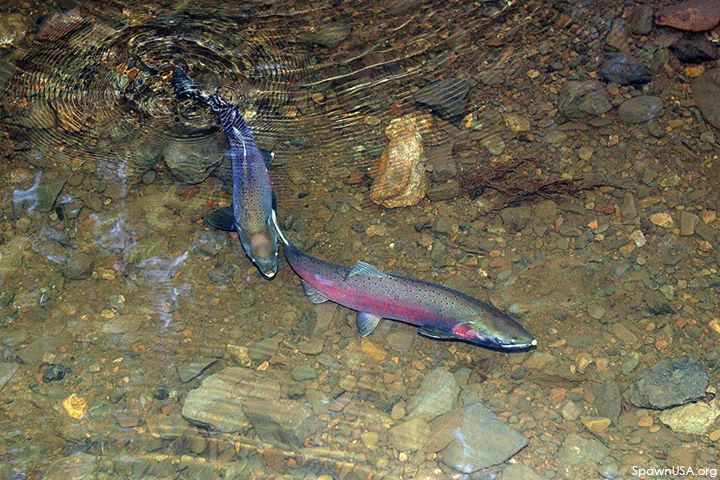San Geronimo, Marin County, CA– The summer sun beats down on Marin County creeks as endangered coho salmon in the San Geronimo Valley are fighting to survive through another drought-stricken year. A series of reports released today by the Marin’s watershed organization, SPAWN, the Salmon Protection And Watershed Network, documents that coho salmon, who normally only spend their first 1.5 years of life in local creeks, were locked in drying streams and inhibited from migrating to sea during last year’s spring drought of record. The report also confirms that since 2006 the small 9 square-mile San Geronimo Valley, representing <10% of the total area of the watershed, produced an average of 40% of all the coho smolts originating from streams in the 102 square mile Lagunitas Creek Watershed.
Each year since 2006, SPAWN Biologists and volunteers have conduct detailed monitoring of the migration of the juvenile coho and steelhead smolts during the spring and summer. An estimated 3,000-6,000 coho smolts, the juvenile salmon maturing for ocean life, migrate to the ocean from the Lagunitas Creek watershed, and in some years as much as half of them originate from the San Geronimo Valley.
“Considering that the Valley represents less than 10% of the total Lagunitas watershed, our results confirm that the San Geronimo Valley is a critically important stronghold for coho and highlights just how important it is to protect habitat here not only for spawning but also as an important nursery area for young coho too.” said Todd Steiner, SPAWN’s Executive Director. Local, state, and federal agencies have recognized the value of the San Geronimo Valley in regional salmon conservation and restoration for many years, but this was largely focused on the spawning habitat. In good years 40% of the total spawning occurs in the San Geronimo Valley. Critical habitat for the endangered coho salmon in the San Geronimo Valley has been degraded as a result of dense, creekside development impacting riparian health, water quality, and natural hydrologic and ecological conditions.
“We also discovered several coho smolts during our smolt monitoring this year that were over 2 years old, which is very unusual for this species” stated SPAWNWatershed Biologist Chris Pincetich. He continued, “Our juvenile fish rescue program relocated a large coho smolt last summer that was obviously trapped in an isolated pool due to the driest spring on record since 1879, and our data now conclusively shows that the age 2+ smolts we sampled this spring occurred in response to drought conditions that impacted the natural migration of these salmon last year.” The age was determined through the careful examination of the fish scales, which naturally fall off during the smolt transformation. Fish growth can be measured by looking at the rings formed in the scales, just like rings in a tree.
The two reports released today are a comprehensive analysis of 4 years worth of monitoring data, including the response of Marin’s coho population to the historic flooding event on New Years Eve 2005. To receive a free copy of the report visit http://www.SpawnUSA.org/pages/page-263 or contact us at (415) 663-8590 ×102, Chris@Tirn.Net.
While the coho are listed as “endangered” under Federal and California law, and have become extinct from the majority of coastal streams in the State, Marin County has some of the best remaining coho habitat left in the State, just 20 miles north of San Francisco. SPAWN leads a popular Creek Naturalist Training in the fall and a public Creekwalk program to see these endangered fish spawning in the winter. The Naturalist Training is scheduled for the weekend of October 10th and 11th, 2009, and registration is currently open through the SPAWN web site. Creek Naturalists that participate in the Training can lead and assist with special field tours on each weekend day in the fall and winter spawning season held throughout the San Geronimo Valley and in partnership with Samuel P. Taylor State Park in and around beautiful Samuel P. Taylor State Park.




